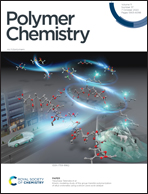Self-assembly and fluorescence emission of UV-responsive azobenzene-containing helical poly(phenyl isocyanide) copolymers†
Abstract
Azobenzene (Azo)-containing phenyl isocyanide (AzoPI, monomer 1) was synthesized via the combination of Williamson etherification and a transesterification reaction, and it could be polymerized to afford poly-1n with the phenyl alkyne–Pd(II) complex as the initiator in a living/controlled manner. Since the obtained poly-1n was living, helical copolymers were obtained through the polymerization of oligo polyethylene glycol group-functionalized phenyl isocyanide (monomer 2) using poly-140 as the macroinitiator. The obtained copolymers were optically active and exhibited light-responsive properties. The poly(140-b-2m) copolymers were amphiphilic and could self-assemble into supramolecular aggregates in aqueous solutions. The TEM results showed that poly(140-b-220) self-assembled to form hollow spindly aggregates with an average length of ∼430 nm and an average diameter of ∼160 nm, while poly(140-b-240) self-assembled into wormlike micelles with an average length of ∼280 nm and an average width of ∼48 nm, and poly(140-b-280) self-assembled into spherical micelles with an average diameter of ∼82 nm. Meanwhile, when α-cyclodextrin (α-CD) was added into the aqueous solution of poly(140-b-240), the wormlike micelles of poly(140-b-240) changed into spherical micelles of the poly(140-b-240)/α-CD complex with an average diameter of ∼104 nm. What's more, due to the UV-response of Azo groups, irregular aggregates of poly(140-b-240) and poly(140-b-240)/α-CD were observed upon UV irradiation. In the meantime, the fluorescence emission of Azo groups was unexpectedly observed in THF solution. When water was added into the THF solution, the intensity of the fluorescence emission became higher. Moreover, the fluorescence intensity increased with the increase in the ratio of water to THF.



 Please wait while we load your content...
Please wait while we load your content...